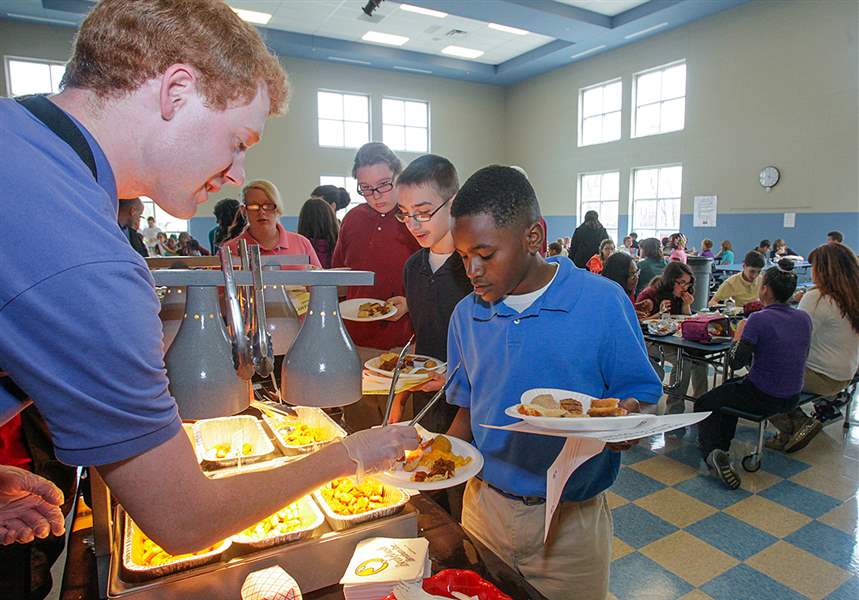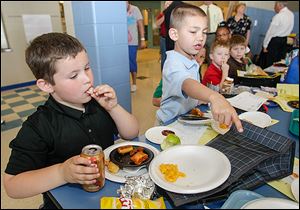
LET’S DO LUNCH
TPS hopes enticing more students to eat will pay off
5/7/2013
Ryan McIntosh serves chicken nuggets to Ka’ron Turner, right, Logan Jeziorowski, behind Ka’ron, and Charlette Hornyak, all seventh graders at Larchmont Elementary School. The school is testing six menu items to see if they make the grade at the school. Nine other schools are helping evaluate meals.
THE BLADE/JETTA FRASER
Buy This Image

Ryan McIntosh serves chicken nuggets to Ka’ron Turner, right, Logan Jeziorowski, behind Ka’ron, and Charlette Hornyak, all seventh graders at Larchmont Elementary School. The school is testing six menu items to see if they make the grade at the school. Nine other schools are helping evaluate meals.
Long have school lunchrooms produced scrunched faces, furrowed brows, and stuck-out tongues from children disappointed by the offerings.
The Toledo Public Schools' food-service budget often prompts similar reactions from grownups.
District food services have run deficits for years, draining resources from the Toledo schools' regular operating budget, money that could otherwise be spent in classrooms.
Between fiscal years 2007 and 2011, the district spent combined about $7.5 million to subsidize the costs of serving breakfast and lunches to its students.
The reasons are many, and the district is trying to fix some of them.
For instance, TPS staffs its cafeterias based on a school's enrollment.
A recent performance audit recommended that staffing be based instead on the number of meals served, which likely would reduce some schools' staffing.
The district also doesn't use point-of-sale machines at its elementary schools, relying on manual labor for paperwork, according to the audit.
Toledo schools have narrowed the deficit somewhat by cutting costs and by expanding the breakfast program, which is profitable, thanks to federal funding.
The U.S. Department of Agriculture's free or reduced-price breakfast program reimburses TPS more for those meals than it costs the district to serve them.
That's mostly because instead of hiring a different crew of employees to work the breakfast shift, TPS asks its foodservice staff to come in about 30 minutes earlier, TPS business manager James Gant said.
Last year, the district began offering free breakfast for every student, regardless of economic status.

Patrick Ford eats a chicken nugget while Alejandro Lucio points to an item he liked on another first grader's plate.
With most Toledo students qualifying for the free meal, and thus yielding a full reimbursement to TPS from the USDA, the bottom line is a winner for TPS.
So far this school year, Mr. Gant said, the Toledo schools have served 300,000 more breakfasts than it did during the same part of the previous year. Staff cuts and improved purchasing control also have helped the district's food budget, he said.
Lunches, however, are still money losers.
Even for students who pay full price, the district charges much less than its costs to serve lunch, and for the vast majority who get federally subsidized lunches, TPS still runs deficits.
Federal reimbursement is just $2.94 for a lunch that costs TPS about $3.11 to serve, Mr. Gant said. That equals more than a quarter lost on every plate of sloppy joes, salisbury steak, or chicken nuggets.
The Toledo Board of Education likely will be asked later this month to raise lunch prices for next year, but that isn't expected to bridge the shortfall by itself.
Labor costs account for more than 40 percent of the TPS food-service budget, and that's where TPS aims to save money, by boosting the number of meals staff serve.
By persuading more students to buy lunch, the labor cost per meal is reduced if no additional staff are hired, while food costs per meal remains constant.
The trick, then, is to get more kids to take the meals. The district tried something new this year, allowing students to taste-test lunch options, in a bid to find meals students actually want to eat.
Students in 10 schools will be surveyed on the offerings, and those surveys will help guide staff in making lunch decisions next year.
Food vendors lined the wall at Larchmont Elementary on Monday, with an array of chicken, tacos, pizzas, hot dogs, and more.
Larchmont students seemed pleased with the offerings.
Seventh-grader Logan Jeziorowski gave Monday's meal a thumbs up, which he normally wouldn't for a school lunch.
“I like flavor in my food,” he said. “It doesn't feel like our food has too much flavor.”
But the samplings he and classmate Ka'ron Turner tried were an improvement, they said.
Ka’ron seemed partial to the chicken and the hot dogs. Most of all, they appreciated that they got to give input on food choices.
“The district never really gives us any choices,” Logan said, “so I think it's a really good thing they are listening to our voices.”
Over at the first-grade table, opinions were more succinct. When asked why he felt Monday's food was better than what he normally gets at school, Drake Hill, 6, needed no time to think.
“Because it's awesome,” he said.
And “awesome” food won't bring any stuck-out tongues.
Contact Nolan Rosenkrans at:
nrosenkrans@theblade.com,
419-724-6086, or on
Twitter @NolanRosenkrans.